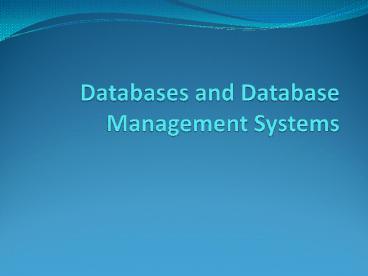Databases and Database Management Systems PowerPoint PPT Presentation
1 / 22
Title: Databases and Database Management Systems
1
Databases and Database Management Systems
2
What is Data? What is the difference between
Data and Information?
3
- Examples of a Database
- Student Records at UCC
- Credit Card details
- Directory Enquiries
- Insurance Broker
- Library System
4
What is data?
- What is data?
- Data is the raw material from which information
is obtained - The processing of data consists of manipulating
it into a form which provides information in a
format that is meaningful and usable to the
manager or other end-user - Arrival of computer processing meant this process
was mimicked. - Automation of existing systems. This is a
traditional file-based system
5
History of Information
- Initially the information needs of an
organisation were met using a manual system.
This system was very labour intensive. - With the arrival of computers, the manual filing
system was moved on to a computer. This early use
of computers for gathering information was called
the file based approach.
6
What is a file-based system?
- A collection of application programs that
perform services for the end-users such as the
production of reports. Each program defines and
manages its own data. (Connolly Begg) - An early attempt to computerise the manual filing
system used - The operation of these systems closely resembles
that of a manual system. All that is really
achieved is the automation of the existing system.
7
File Based Approach
RESPONSIBILITY HELD
APPLICATIONS
DATA HELD
PAYROLL PROGRAM
Employee Name, Age, Address, Hours, Pay Rate
Payroll Dept.
ADMIN. PROGRAM
Dept. Name, Employee Name, Emp. Address, Office
Location
Dept. Managers
PROJECT SCHEDULING PROGRAM
Project Name, Start Date, Staff Name, Staff
Address, Project Hours
Project Leaders
8
What are the limitations of the file-based system?
- Separation and isolation of data
- Decentralised data makes cross-referenced
searching slow and difficult - Duplication of Data
- Wastes time and money for entering and storage,
leads to corruption of data integrity - Program-Data Dependence
9
What are the limitations of the file-based system?
- Incompatibility of files
- Structure and format is dependent on the
development language and platform of the
application - Fixed queries and proliferation of application
programs - Ad Hoc querying and reporting code to be written
from scratch
10
What is a Database?
- a shared collection of logically related data
(and a description of this data), designed to
meet the information needs of an organisation
(Connolly Begg) - Implications? Centralised (minimal duplication),
self-describing (program independent to an
extent), logical structure (entities, attributes
and relationships).
11
Advantages of a Database
- Data Integrity is easier to maintain as all data
is held in on central location - A database system allows for ad-hoc queries and
caters to complex questions involving the
interaction and relationships between the various
data items in the database to be investigated - Security
- Minimisation of data duplication
- Control of data redundancy
- Improved Maintenance
12
Disadvantages of a Database
- Complexity increased functionality means the
system is more complex and sophisticated in
structure - Size complexity and functionality makes the
DBMS a large piece of software, taking up a lot
of space - Cost of DBMSs the cost can vary depending on
functionality required and the environment - Additional Hardware Costs
- Cost of Conversion - conversion of existing
systems - High Impact of Failure - as a result of
centralisation
13
What is a DBMS?
- The DBMS is a piece of software whose main
function is to organise data so it can be
retrieved, modified or updated at will. It is the
link between the user and the data, giving access
to the data required for the systems and their
application programs. - A software system that enables users to define,
create, and maintain the database and provides
controlled access to this database (Connolly
Begg).
14
Database Management System
APPLICATIONS
DATA HELD
PAYROLL PROGRAM
Database
ADMIN. PROGRAM
Employee Administration and project Details
DBMS
PROJECT SCHEDULING PROGRAM
15
Explanation of a DBMS
- In the database structure, each system draws its
data via the database management system, so each
systems program interacts with the DBMS rather
than the database files themselves (e.g MS
Access) - A DBMS can be described as an intelligent filing
cabinet, as it performs all the functions of an
efficient filing clerk
16
Components of a DBMS
- Data definition language is used to define the
database (types, structure and constraints) - Data Manipulation Language is used to insert,
update, delete and retrieve data. Utilises a
flexible, ad hoc, query language - There are two types of query language, procedural
(one record at a time, specifies how) and
non-procedural (sets of records, specifies
what). - Access control includes security, integrity,
concurrency, recovery and catalogues.
17
Components of a DBMS
- End-users use VIEWS which makes the DBMS
transparent in its activities - A DBMS consists of hardware (machines, network
connections, physical storage), software (OS,
DBMS, applications), data, procedures and people
(administrators, designers (logical and
physical), programmers and end-users. - Advantages Less redundancy, improved
consistency, information, integrity, security,
scalability, flexibility, productivity,
concurrency, maintenance and recovery. - Disadvantages complexity, size, cost,
generalisation, high impact of failure.
18
Roles in Database Management System
- Database Administrator
- Database Designers
- Application Programmers
- End-Users
19
Architecture
- Most DBMSs use a three-level architecture
External, Internal and Conceptual - Internal - describes how the data is stored in
the database (space allocation, compression,
encryption etc.) and interfaces with the OS to
manage files in physical storage - Conceptual - Describes what data is stored and
the relationships between data - External - Defines the users view of the data
20
(No Transcript)
21
(No Transcript)
22
Reasons for Three-Tier Architecture

